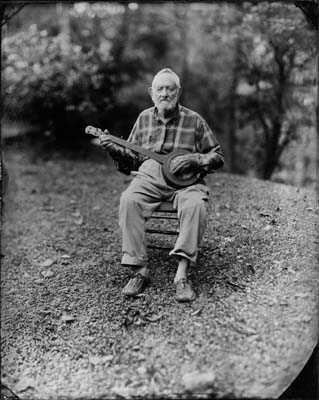Lisa Elmaleh and the Modern Art of Tintype
By John Lilly | Photographs by Lisa Elmaleh

Frank George with banjo.
As the art of photography becomes more digital, automated, and instantaneous, a young woman in Paw Paw, Morgan County, is devoting herself to the time-honored and painstaking process of creating tintype images for the 21st century. Lisa Elmaleh prefers the look of the older, analog photographs. So she learned – and now teaches – the laborious process of taking and developing tintype photographs.
The subject of her photography is unique, as well. Fascinated by West Virginia old-time musicians, Lisa has spent the last five years traveling around the state making portraits of fiddle, banjo, guitar, dulcimer, accordion, and mandolin players, as well as at least one flatfoot dancer. Lisa estimates that she has taken more than 400 tintypes of West Virginia old-time musicians, and has documented more than 100 individuals and groups.
The daughter of a photographer, Lisa was captivated by the strange and magical world of film photography; she loved watching her father evoke visions on paper through the chemical processes used in developing, enlarging, and printing his pictures. A Miami, Florida, native, Lisa eventually went to school in New York to study photography and attended a workshop in tintype photography in New Mexico.
Tintype was developed in Ohio in the late 1850’s and came into popular use during the Civil War. Its popularity continued into the 1920’s when it faded in favor of other photographic systems. At its peak during the 1860’s and ‘70’s, however, tintype offered a durable and affordable alternative to the earlier glass-plate photographs.
You can read the rest of this article in this issue of Goldenseal, available in bookstores, libraries or direct from Goldenseal.